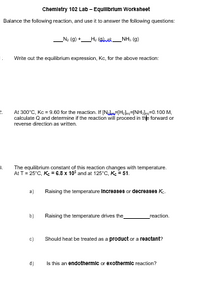
Chemistry
10th Edition
ISBN: 9781305957404
Author: Steven S. Zumdahl, Susan A. Zumdahl, Donald J. DeCoste
Publisher: Cengage Learning
expand_more
expand_more
format_list_bulleted
Question

Transcribed Image Text:Chemletry 102 Lab - Equilibrium Worksheet
Balance the following reaction, and use it to answer the following questions:
_N. (g) +_H: (ghi_NH. (g)
1.
Write aut the equilibrium expression, Ke, for the above reacian:
At 300°C, Kc = 9.60 for the reaction. If (NlHl=[NHle=0.100 M,
calculate Q and determine if the reaction will proceed in the forward or
reverse direction as written.
3.
The equilibrium constant of this reaction changes with temperature.
AtT= 25'C, Ke = 6.8 x 10 and at 125'C, Ke = 51.
Raising the temperature Increases or decreases K.
a)
b)
Raising the temperature drives the
reaction.
c)
Should heat be treated as a product ar a reactant?
d)
Is this an endothermic or exothermic reaction?
Expert Solution
This question has been solved!
Explore an expertly crafted, step-by-step solution for a thorough understanding of key concepts.
This is a popular solution
Trending nowThis is a popular solution!
Step by stepSolved in 2 steps

Knowledge Booster
Learn more about
Need a deep-dive on the concept behind this application? Look no further. Learn more about this topic, chemistry and related others by exploring similar questions and additional content below.Similar questions
- 7. (1 Consider the reaction: N₂(g) + O₂(g) = 2NO(g); Kc 1.0x10-6. Suppose a sample of air 08) contains initially [N₂]=0.80M and [0₂]=0.20M. Use the neglect x approach to calculate the equilibrium concentration of all reactants and products at equilibrium. As part of your answer show that neglect x is valid. ausdi noitulos senisinoo vilsitini erudsteamet nisheo s is sutxim notlosen MEP1.0 of IH to noite insonoo eri bnuol esw mundilupe how Tuoy wor12 slab bebivo1q erit ritiw eldst 301 ne we10 sarrow_forwardConsider the equilibrium system described by the chemical reaction below, which has a value of Kc equal to 7.1 × 10-4 at a certain temperature. If a solid sample of CaCro4 dissolves in solution, what will the equilibrium concentration of Ca2* in the solution be? СacrOa(s) 3D са?" (аq) + CrO,? (aq) 2- 1 2 3 NEXT > Based on the given values, set up ICE table in order to determine the unknown. CaCrO4(s) Ca²*(aq) CrO,2 (aq) + Initial (M) Change (M) Equilibrium (M)arrow_forward7 Please dont provide the handwritten solutionarrow_forward
- 46)arrow_forwardConsider the reaction, 2AB2(g) = A2(g) + 2B2(g), Kc = 0.263 at 25°C. The reaction begins with an unknown concentration of AB2 in the reaction flask. At equilibrium, the concentration of AB2 is found to be 0.00545 M. a) Complete the ICEE table below, b) Write the equilibrium expression and equation for this reaction (pay close attention to coefficients!), c) Calculate the equilibrium concentration of both products, and d) Calculate the initial concentration of AB2. You should confirm that your equilibrium concentrations will give the correct equilibrium constant when plugged into the expression. ICEE table I C E 2 AB₂(g) A₂(g) + 2 B₂(g)arrow_forward5 please don't provide handwritten solutionarrow_forward
- Iodine and bromine react to give iodine monobromide, IBr. I1 (9) + Brz (9) = 2IB:(9) What is the equilibrium composition of a mixture at 154°C that initially contained 1.10 x 10- mol each of iodine and bromine in a 5.00 L vessel? The equilibrium constant K, for this reaction at 154°C is 130. [1:] =( M [Bra] =( M [IBr] = Marrow_forwardPlease help with thisarrow_forward
arrow_back_ios
arrow_forward_ios
Recommended textbooks for you
 ChemistryChemistryISBN:9781305957404Author:Steven S. Zumdahl, Susan A. Zumdahl, Donald J. DeCostePublisher:Cengage Learning
ChemistryChemistryISBN:9781305957404Author:Steven S. Zumdahl, Susan A. Zumdahl, Donald J. DeCostePublisher:Cengage Learning ChemistryChemistryISBN:9781259911156Author:Raymond Chang Dr., Jason Overby ProfessorPublisher:McGraw-Hill Education
ChemistryChemistryISBN:9781259911156Author:Raymond Chang Dr., Jason Overby ProfessorPublisher:McGraw-Hill Education Principles of Instrumental AnalysisChemistryISBN:9781305577213Author:Douglas A. Skoog, F. James Holler, Stanley R. CrouchPublisher:Cengage Learning
Principles of Instrumental AnalysisChemistryISBN:9781305577213Author:Douglas A. Skoog, F. James Holler, Stanley R. CrouchPublisher:Cengage Learning Organic ChemistryChemistryISBN:9780078021558Author:Janice Gorzynski Smith Dr.Publisher:McGraw-Hill Education
Organic ChemistryChemistryISBN:9780078021558Author:Janice Gorzynski Smith Dr.Publisher:McGraw-Hill Education Chemistry: Principles and ReactionsChemistryISBN:9781305079373Author:William L. Masterton, Cecile N. HurleyPublisher:Cengage Learning
Chemistry: Principles and ReactionsChemistryISBN:9781305079373Author:William L. Masterton, Cecile N. HurleyPublisher:Cengage Learning Elementary Principles of Chemical Processes, Bind...ChemistryISBN:9781118431221Author:Richard M. Felder, Ronald W. Rousseau, Lisa G. BullardPublisher:WILEY
Elementary Principles of Chemical Processes, Bind...ChemistryISBN:9781118431221Author:Richard M. Felder, Ronald W. Rousseau, Lisa G. BullardPublisher:WILEY

Chemistry
Chemistry
ISBN:9781305957404
Author:Steven S. Zumdahl, Susan A. Zumdahl, Donald J. DeCoste
Publisher:Cengage Learning

Chemistry
Chemistry
ISBN:9781259911156
Author:Raymond Chang Dr., Jason Overby Professor
Publisher:McGraw-Hill Education

Principles of Instrumental Analysis
Chemistry
ISBN:9781305577213
Author:Douglas A. Skoog, F. James Holler, Stanley R. Crouch
Publisher:Cengage Learning

Organic Chemistry
Chemistry
ISBN:9780078021558
Author:Janice Gorzynski Smith Dr.
Publisher:McGraw-Hill Education

Chemistry: Principles and Reactions
Chemistry
ISBN:9781305079373
Author:William L. Masterton, Cecile N. Hurley
Publisher:Cengage Learning

Elementary Principles of Chemical Processes, Bind...
Chemistry
ISBN:9781118431221
Author:Richard M. Felder, Ronald W. Rousseau, Lisa G. Bullard
Publisher:WILEY